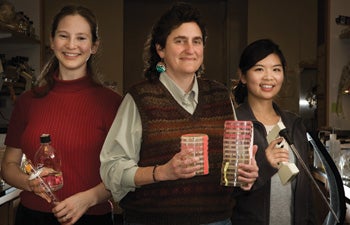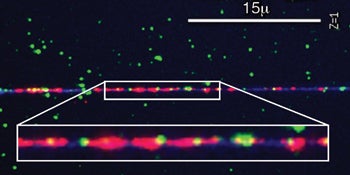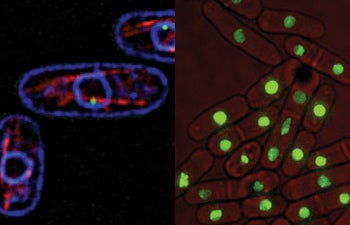Yeast Unleashed
There is good reason Susan Forsburg’s laboratory smells of sourdough.
The USC College biologist is among the most prominent fission yeast researchers in the country. Inside her lab are hundreds of petri dishes containing cultures of Schizosaccharomyces pombe — a single-celled fungus Forsburg and her team use to study DNA damage and mutation that in humans may lead to cancer.
“It’s a friendly, fast, nontoxic organism,” said Sarah Sabatinos, one of two postdoctoral researchers who work in the Forsburg laboratory, along with six graduate students, five undergraduates and three technicians. “And it smells good, too.”
Providing a deeper understanding of how cells work, Forsburg’s research will ultimately be used as the foundation to improve treatment and seek cures for cancer.

Susan Forsburg (center) holds petri dishes containing S. pombe inside her lab, with postdoctoral researcher Sarah Sabatinos (left) and Ph.D. student Pao-Chen Li. Photo by Eric O’Connell.
“I don’t expect anything I do to cure cancer,” Forsburg said bluntly. “The way basic science works is every scientist puts a brick in the wall. And the person who makes news is the scientist who puts the last brick in the wall. But he or she wouldn’t be anywhere without all the pieces underneath.”
Forsburg’s expertise — S. pombe — is dubbed a micro-mammal because it can be used as a genetic system to model processes that apply to higher cells. Pombe means beer in Swahili. The yeast was originally isolated in 1893 from East African millet beer.
The fungus can be used for brewing, but the beer can taste and smell of sulfur, akin to rotten eggs. It also can be used to bake, but the bread won’t rise as well as if made from baker’s yeast — or Saccharomyces cerevisiae — the most common yeast microbiologists use to research cell division.
“We’re the other yeast,” Sabatinos said. “S. pombe is a great model organism that can answer basic research questions. I think of pombe as a cross between humans and plants. Pombe has many of the genes humans have.”
When giving presentations for the American Cancer Society, Forsburg tells the audience to consider a pombe cell a lawnmower and a mammalian cell a Mercedes Benz.
“We can learn from a simple piece of machinery like a lawnmower before seeing how the Mercedes works,” Forsburg tells the audience.
If you Google S. pombe, Forsburg’s award-winning Web site PombeNet is among the top results. The site answers myriad questions about fission yeast research. During an interview, Forsburg elaborated, explaining that normal cell division is essential to healthy development in human and yeast cells. Since human cells are so complicated, it is easier to establish basic principles in simple model organisms.

This photomicrograph shows chromosomes stretched out from S. pombe cells. Newly synthesized DNA is labeled in red, and the mini-chromosome maintenance (MCM) helicase, which unwinds the DNA for replication, is marked in green. As expected, it falls at the boundary of the new DNA synthesis. The blue labels all the DNA. The white bar is 15 microns. Image courtesy of S. Forsburg.
Scientists know that malfunctions during cell division can lead to cancer or birth defects. Forsburg researches a crucial part of cell division: the start of the replication of DNA in the parent cell prior to the point when it distributes its DNA among its daughter cells. Each human DNA molecule is comprised of chemical bases arranged in 3 billion sequences. If laid end-to-end, the DNA in a single human cell measures 3 1/3 feet.
The DNA of one cell contains so much information that if represented in printed words, listing just the first letter of each base would require more than 1.5 million pages of text. Mistakes in copying or repairing DNA can result in cancer.
“A characteristic of cancer cells is genome instability,” Forsburg said. “Cells can start to make more mistakes; they may not replicate properly or divide properly. They break their chromosomes, they lose chromosomes, they have too many of one, not enough of another. This leads to disruptions in gene activities. So we’re using fission yeast as a model system to try to understand the cellular mechanisms that create genome instability.”
S. pombe cells grow quickly, between two and four hours, and they are easy to manipulate in the laboratory.
“I’m a really passionate advocate for the organism,” Forsburg said. “I basically proselytize the use of this system for studying problems relating to how chromosomes behave.”
She shows her advocacy with a touch of humor. On her office wall hangs a photograph of the famous Hollywood sign. But rather than Hollywood, she Photoshopped the iconic white letters to say “Pombewood” and made Pombewood T-shirts for her students.
On another wall is a photo of Sir Paul Nurse, Leland Hartwell and Timothy Hunt, awarded the 2001 Nobel Prize in Physiology or Medicine for their cell division cycle research. Nurse investigated the life cycle of S. pombe, discovering a key gene species that helps control cell division. He was the scientist who transformed S. pombe into a forefront model system.

These are S. pombe cells (left). The membranes (nucleus and cell periphery) are labeled in blue, the microtubules of the cytoskeleton are in red and the centromeres are in green. The image on the right shows S. pombe cells with a division defect. The chromosomes are labeled with histone green fluorescent protein (GFP). Notice one cell in the middle has three nuclei; it has suffered a chromosome segregation defect and is losing several chromosomes. Image courtesy of S. Forsburg.
As a postdoc at Oxford University, Forsburg worked in Nurse’s lab. She earned her bachelor’s in molecular biology and English literature at the University of California, Berkeley (her hometown), and Ph.D. at the Massachusetts Institute of Technology.
When Forsburg returned to the United States in 1993 to become an assistant professor at the Salk Institute for Biological Studies in La Jolla, Calif., she began receiving queries about pombe. She created pombe.net and has become the nation’s unofficial pombe spokesperson.
At USC College since 2004, Forsburg has earned numerous honors, including being named a fellow of the American Association for the Advancement of Science, the Association for Women in Science and the USC Center for Excellence in Research. She also received a USC-Mellon Award for Excellence in Mentoring.
She is on the American Cancer Society’s Council for Extramural Grants and speaks to potential donors about her research.
“You may think that a talk about yeast research would be like watching ice melt,” said Gail Berlant, director for distinguished giving at the organization’s Los Angeles office. “But Susan makes people excited about what she does. Scientists like Susan are society’s true rock stars.”
Forsburg is also well known for her work in USC’s Women in Science and Engineering (WiSE), committed to increasing the success of women in science. On WiSE’s advisory board, she also runs www.womenbio.net, a Web site she started in 1997.
She strives to help remove the barriers women face in the sciences.
“Those of us who are more senior and are in a position to effect change should do it,” Forsburg said.
In addition to being a scientist, Forsburg is married with two stepchildren ages 20 and 18. She and her wife, Lisa Churchill, a grants administrator, have a parrot and two cats at their San Diego home. Forsburg commutes daily by train and bus, using the three-hour trek each way to review and write papers and lectures on her laptop.
A popular teacher, students from Forsburg’s advanced molecular biology class recently rated her 4.96 out of 5. She also teaches the seminar classes “Advanced Molecular Biology,” “Advanced Genetics Through the Literature” and “Biology of Cancer.”
Each day, she oversees students’ lab research. During a recent visit, the lab bustled with activity.
Sabatinos is studying DNA replication, focusing on what occurs midway through the process when the replication fork structure is disturbed.
“Does the fork complex stabilize or do components dissociate?” she asked.
Opening one of the many freezers, Sabatinos removed a vial of pombe. Using a toothpick, she smeared some frozen pombe on a plate and placed the plate inside an incubator to “wake them up.” In three days, the yeast will form colonies to use in experiments.
Sabatinos comes from Canada, where she earned her Ph.D. at the University of Toronto. Forsburg created an opportunity for Sabatinos’ biologist husband to become a microscopy expert after interviewing him separately.
“More than likely, I’d still be in Toronto if not for Susan,” Marc Green said.
Pao-Chen Li, a fifth-year Ph.D. student, is researching the protein Swi6, a key component at the DNA’s centromere — the region in a chromosome’s highly packed midpoint. She uses the lab’s DeltaVision deconvolution microscope to make multi-colored fluorescent images and 3-D rotatable reconstructions of her research. From the images, she makes movies she uses for research and teaching.
Forsburg’s teaching assistant for two semesters, Li won USC’s 2008 Outstanding Teaching Assistant Award.
“Pombe is an important research tool, but the main reason I chose this lab is because of Susan,” Li said. “For a Ph.D. student, good mentoring is the most important thing.”
Undergrads are also thriving in the Forsburg lab. Cara Bickers, a biology junior, is searching for a specific gene that produces a protein used in two different parts of a cell cycle.
“She’s tough,” Bickers said of Forsburg. “You just know she expects quality work from you. She’s very good at pushing you forward.”
Read more articles from USC College Magazine’s Spring/Summer 2010 issue.